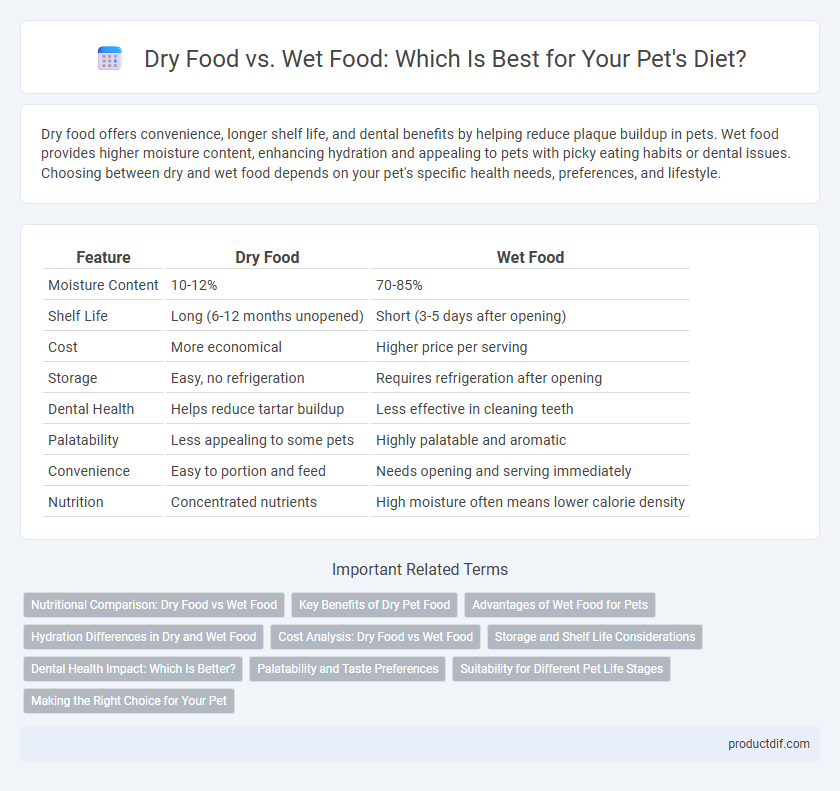Dry food offers convenience, longer shelf life, and dental benefits by helping reduce plaque buildup in pets. Wet food provides higher moisture content, enhancing hydration and appealing to pets with picky eating habits or dental issues. Choosing between dry and wet food depends on your pet's specific health needs, preferences, and lifestyle.
Table of Comparison
| Feature | Dry Food | Wet Food |
|---|---|---|
| Moisture Content | 10-12% | 70-85% |
| Shelf Life | Long (6-12 months unopened) | Short (3-5 days after opening) |
| Cost | More economical | Higher price per serving |
| Storage | Easy, no refrigeration | Requires refrigeration after opening |
| Dental Health | Helps reduce tartar buildup | Less effective in cleaning teeth |
| Palatability | Less appealing to some pets | Highly palatable and aromatic |
| Convenience | Easy to portion and feed | Needs opening and serving immediately |
| Nutrition | Concentrated nutrients | High moisture often means lower calorie density |
Nutritional Comparison: Dry Food vs Wet Food
Dry food typically contains higher carbohydrate levels and lower moisture content, providing long shelf life and dental benefits for pets. Wet food offers increased moisture, essential for hydration, and usually contains higher protein and fat levels, making it more palatable and nutrient-dense. Choosing between dry and wet food depends on a pet's specific dietary needs, health conditions, and preferences for optimal nutrition.
Key Benefits of Dry Pet Food
Dry pet food offers enhanced dental health by reducing plaque and tartar buildup due to its crunchy texture. It provides convenience with longer shelf life and easier storage compared to wet food. High in calories and nutrients, dry food supports active pets' energy needs while promoting optimal digestive health with added fiber.
Advantages of Wet Food for Pets
Wet food offers higher moisture content, promoting better hydration and supporting urinary tract health in pets. Its softer texture is ideal for animals with dental issues or sensitive teeth, ensuring easier consumption and digestion. Rich in protein and often more palatable, wet food enhances appetite and provides essential nutrients for overall pet wellness.
Hydration Differences in Dry and Wet Food
Wet pet food contains approximately 70-85% moisture, significantly increasing pet hydration compared to dry food, which typically contains only 10-12% moisture. Pets consuming dry food often require additional water intake to maintain optimal hydration and prevent urinary tract issues. Proper hydration supports overall kidney function and helps maintain healthy skin and coat in pets.
Cost Analysis: Dry Food vs Wet Food
Dry food typically costs less per serving compared to wet food, making it a more budget-friendly option for pet owners seeking economical nutrition. Wet food, while more expensive, offers higher moisture content and palatability, which can benefit pets with specific health needs but increases monthly feeding expenses. Evaluating cost per calorie and portion size helps in making an informed decision between dry and wet pet food based on budget constraints.
Storage and Shelf Life Considerations
Dry pet food offers longer shelf life and easier storage due to its low moisture content, typically lasting six to twelve months when kept in a cool, dry place. Wet pet food, with high moisture content, requires refrigeration after opening and generally lasts only three to five days once opened, posing storage challenges. Proper storage of dry food in airtight containers preserves freshness and prevents pest contamination, while unopened wet food cans or pouches maintain quality for up to two years under optimal conditions.
Dental Health Impact: Which Is Better?
Dry food promotes dental health by helping to reduce plaque and tartar buildup through its abrasive texture, which mechanically scrubs teeth during chewing. Wet food, while often more palatable and hydrating, tends to adhere to teeth and can increase the risk of plaque accumulation and dental disease if oral hygiene is not maintained. Regular dental care and veterinary check-ups remain essential regardless of the pet's diet to ensure optimal oral health.
Palatability and Taste Preferences
Dry food offers a crunchy texture that many pets find satisfying, promoting dental health while providing consistent flavor. Wet food contains higher moisture levels and often features richer aromas and softer textures, enhancing palatability and appealing to picky eaters. Taste preferences vary among pets, with some favoring the savory richness of wet food and others preferring the texture and flavor intensity of dry kibble.
Suitability for Different Pet Life Stages
Dry food is ideal for adult pets due to its balanced nutrient profile and dental benefits, supporting long-term health maintenance. Wet food provides higher moisture content and is better suited for puppies, kittens, and senior pets who require increased hydration and easier digestion. Choosing the right pet food based on life stage ensures optimal growth, energy levels, and overall well-being.
Making the Right Choice for Your Pet
Selecting between dry food and wet food for your pet hinges on factors such as age, health needs, and dietary preferences. Dry food offers dental benefits and convenience, while wet food provides higher moisture content and palatability. Consulting with a veterinarian ensures a balanced diet tailored to your pet's specific nutritional requirements.
Dry Food vs Wet Food Infographic

 productdif.com
productdif.com